#include <vector>
#include <queue>
#include <iostream>
#include <cmath>
#include <algorithm>
#include <deque>
#include <numeric>
#include <map>
#define ll long long
using namespace std;
int N,M,ans=1e9;
char board[55][55];
int dx[4] = {0, 1, 0, -1};
int dy[4] = {1, 0, -1, 0};
map<char,bool> key;
pair<int,int> ms;
void DFS(int y, int x, int tot)
{
queue<pair<int,int>> q;
int cost[55][55];
for(int i=0;i<N;i++)
fill(cost[i], cost[i]+55, -1);
cost[y][x] = 0;
q.push({y,x});
while(!q.empty())
{
auto cur = q.front(); q.pop();
for(int dir=0;dir<4;dir++)
{
int ny = cur.first + dy[dir];
int nx = cur.second + dx[dir];
if(nx<0 or ny<0 or nx>=M or ny>=N) continue;
if(cost[ny][nx] >= 0 or board[ny][nx] == '#') continue;
cost[ny][nx] = cost[cur.first][cur.second] + 1;
if(board[ny][nx] >= 'A' and board[ny][nx] <= 'F'){
if(!key[board[ny][nx]]) continue;
}else if(board[ny][nx] >= 'a' and board[ny][nx] <= 'f'){
find++;
if(key[board[ny][nx]-32]) goto jump;
key[board[ny][nx] - 32] = true;
char tmp = board[ny][nx];
board[ny][nx] = '.';
DFS(ny, nx, tot+cost[ny][nx]);
board[ny][nx] = tmp;
key[board[ny][nx] - 32] = false;
continue;
}else if(board[ny][nx] == '1'){
ans = min(ans, tot+cost[ny][nx]);
return;
}
jump:;
q.push({ny,nx});
}
}
}
int main() {
ios::sync_with_stdio(0);
cin.tie(0);
cout.tie(0);
cin >> N >> M;
for(int i=0;i<N;i++)
for(int j=0;j<M;j++)
{
cin >> board[i][j];
if(board[i][j] == '0') ms = {i,j};
}
DFS(ms.first, ms.second, 0);
if(ans == 1e9) ans = -1;
cout << ans;
return 0;
}
- 풀이 & 한계
열쇠('a' ~ 'f')를 만나면 해당 좌표부터 새로운 BFS를 수행 + map을 통해 현재 보유한 key관리
(key는 백트래킹으로 나왔을 때에는 다시 false처리를 했음)N과 M이 50이라는 큰 숫자에서 DFS를 했고, 최적 조건시 exit(0)할수도 없음
--> 무조건 전부 수행해야 하니까 시간초과가 발생
- 필요한 로직
: 3차원 배열 [key][ny][nx]를 통해서 board에 있을 때 현재 어떤 키를 보유한 상태인지에 따라 구분해서 관리하면 하나의 BFS로 수행 가능
#include <vector>
#include <queue>
#include <iostream>
#include <cmath>
#include <algorithm>
#include <deque>
#include <numeric>
#include <map>
#define ll long long
using namespace std;
int N,M,ans=1e9;
char board[55][55];
bool vis[65][51][51];
int dx[4] = {0, 1, 0, -1};
int dy[4] = {1, 0, -1, 0};
pair<int,int> ms;
struct info{
int y;
int x;
int cost;
int key;
};
bool checkKey(char c, int key){
int result = key & (1 << ((int)c - 'A'));
if(result != 0) return true;
return false;
}
int main() {
ios::sync_with_stdio(0);
cin.tie(0);
cout.tie(0);
cin >> N >> M;
for(int i=0;i<N;i++)
for(int j=0;j<M;j++)
{
cin >> board[i][j];
if(board[i][j] == '0') ms = {i,j};
}
queue<info> q;
info t = {ms.first, ms.second, 0, 0};
q.push(t);
while(!q.empty())
{
auto cur = q.front(); q.pop();
for(int dir=0;dir<4;dir++)
{
int ny = cur.y + dy[dir];
int nx = cur.x + dx[dir];
int cur_cost = cur.cost;
int key = cur.key;
if(nx<0 or ny<0 or nx>=M or ny>=N) continue;
if(board[ny][nx] == '#' or vis[key][ny][nx]) continue;
if(board[ny][nx] >= 'A' and board[ny][nx] <= 'F'){
if(!checkKey(board[ny][nx], key)) continue;
}else if(board[ny][nx] >= 'a' and board[ny][nx] <= 'f'){
key = key | (1 << ((int)board[ny][nx]-'a'));
}else if(board[ny][nx] == '1'){
cout << cur_cost + 1;
return 0;
}
vis[key][ny][nx] = true;
info t = {ny, nx, cur_cost+1, key};
q.push(t);
}
}
cout << -1;
return 0;
}
- 로직
BFS를 수행하는데 queue에 4가지 정보를 유지 (y / x / cost / key)현재 어떤 키를 가지고 있는지 key 변수로 관리하며, 비트마스킹을 이용해서 경우를 나눔
--> 비트마스킹 + shift연산 으로 현재 가진 키를 표현
--> ex)
키 a를 가짐 : 000001
키 a,d를 가짐 : 001001
... key는 총 6개니까 (1<<6) 즉, 키를 가지는 경우는 총 64개가 나온다BFS를 수행하면서 board값이 1인 점을 만나면 바로 종료
--> BFS니까 최단 경로를 의미
- 느낀 점
프로그래머스의 활주로 건설 처럼 최단경로를 구하는데,
각 board에서 다양한 상태를 가질 수 있다면 3차원 배열을 이용해서 하나의 BFS로 풀어낼 수 있음비트마스킹 + shift 연산으로 key값을 관리하는 것이 매우 신기

